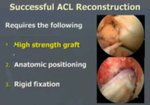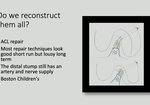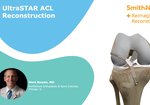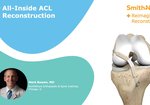Playback speed
10 seconds
Antero-Lateral Extra-Articular Modified Lemaire Tenodesis in ACL Reconstruction Surgery
0 views
January 9, 2018
Postoperative Pivot-Shift and rotational instability are a common cause of failure and unsatisfactory outcomes after ...
read more ↘ ACL reconstruction surgery. The trend is to perform anatomic, independent femoral drilling reconstructions, resulting in a more oblique disposition of the graft, improving rotational control. Unfortunately residual Pivot-Shift can be as high as 25-38% in correctly performed anatomic reconstructions. This is probably because our incapability in reproducing the real complex anatomy of the ligament and because there are other structures injured during the initial giving way episode, mainly the antero-lateral structures and the antero-lateral ligament.
Multiple techniques have been described for antero-lateral tenodesis and lately anatomic ALL reconstruction has been highlighted. Unfortunately the proper anatomic insertions of the ligament are not clear and results in the literature are confusing. This could compromise range of motion in case of improper placement.
Modified Lemaire extra-articular tenodesis has several advantages over anatomic ALL reconstructions. First, only one insertion site has to be selected, the proximal insertion site, proximal and posterior to the lateral epicondyle. Second, this insertion site can be moved proximally if needed (in case of hardware presence or previous tunnels in revision surgery) not affecting graft behavior once it is passed under the lateral colateral ligament, used as a hinge. Third, only an extra interference screw in utilized. Fourth, tunnel convergence is unlikely if performed associated to anatomic intra-articular ACL reconstruction. Care should be taken if used with non-anatomic trans-tibial reconstruction.
The graft should be fixed in maximum knee extension in order to avoid postoperative knee stiffness. The graft should be lax in flexion, allowing physiologic knee rotation and tight in extension limiting internal rotation and residual Pivot-Shift.
We have been extending our indications because of the good postoperative rotational control and the low morbidity and complication rate. We are now associating intra + extra-articular reconstructions in all cases with increased risk of residual Pivot-Shift. This is, to all revision cases, high grade Pivot-Shift, contact athletes, chronic cases, young patients including pediatric cases, genu recurvatum and multi-ligament reconstructions.
We are also using this technique as an isolated procedure, opposed to a complete revision, in cases of residual rotational instability after non-anatomic trans-tibial reconstruction, were Lachman is negative but Pivot-Shift is positive, satisfactorily controlling rotational instability with faster recovery and high patient satisfaction.
↖ read less
read more ↘ ACL reconstruction surgery. The trend is to perform anatomic, independent femoral drilling reconstructions, resulting in a more oblique disposition of the graft, improving rotational control. Unfortunately residual Pivot-Shift can be as high as 25-38% in correctly performed anatomic reconstructions. This is probably because our incapability in reproducing the real complex anatomy of the ligament and because there are other structures injured during the initial giving way episode, mainly the antero-lateral structures and the antero-lateral ligament.
Multiple techniques have been described for antero-lateral tenodesis and lately anatomic ALL reconstruction has been highlighted. Unfortunately the proper anatomic insertions of the ligament are not clear and results in the literature are confusing. This could compromise range of motion in case of improper placement.
Modified Lemaire extra-articular tenodesis has several advantages over anatomic ALL reconstructions. First, only one insertion site has to be selected, the proximal insertion site, proximal and posterior to the lateral epicondyle. Second, this insertion site can be moved proximally if needed (in case of hardware presence or previous tunnels in revision surgery) not affecting graft behavior once it is passed under the lateral colateral ligament, used as a hinge. Third, only an extra interference screw in utilized. Fourth, tunnel convergence is unlikely if performed associated to anatomic intra-articular ACL reconstruction. Care should be taken if used with non-anatomic trans-tibial reconstruction.
The graft should be fixed in maximum knee extension in order to avoid postoperative knee stiffness. The graft should be lax in flexion, allowing physiologic knee rotation and tight in extension limiting internal rotation and residual Pivot-Shift.
We have been extending our indications because of the good postoperative rotational control and the low morbidity and complication rate. We are now associating intra + extra-articular reconstructions in all cases with increased risk of residual Pivot-Shift. This is, to all revision cases, high grade Pivot-Shift, contact athletes, chronic cases, young patients including pediatric cases, genu recurvatum and multi-ligament reconstructions.
We are also using this technique as an isolated procedure, opposed to a complete revision, in cases of residual rotational instability after non-anatomic trans-tibial reconstruction, were Lachman is negative but Pivot-Shift is positive, satisfactorily controlling rotational instability with faster recovery and high patient satisfaction.
↖ read less
Comments 14
Login to view comments.
Click here to Login


















